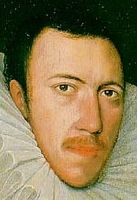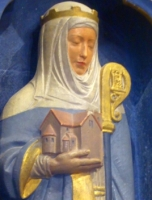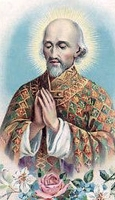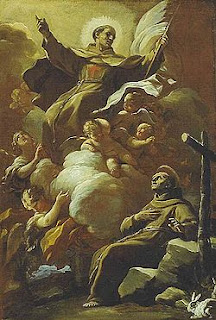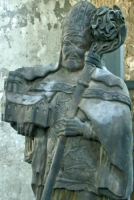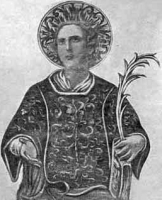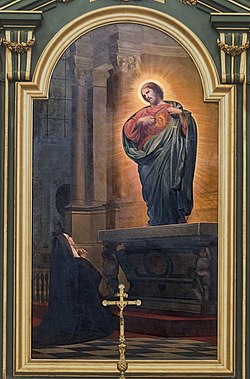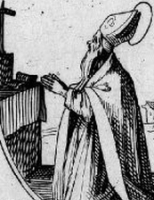St. John of Rila
Feastday: October 19
Birth: 876
Death: 946
John of Rila One of the first Bulgarian monastics, St. John of Rila was born c. 876/880 near Kjustendil. As a young man, he entered a monastery and eventually became a hermit in the mountains north of Sofia. As his disciples gathered around him, the monastery at Rila was established and flourished. John believed that monks should live in harmony and should include manual labor among their spiritual works. His rule is his only surviving work. He is said to have refused to receive Tsar Peter, co-ruler of Bulgaria and a supporter of monasticism, because monks should have no contact with the princes of the world. After John's death in 946, his body was translated to Sofia and eventually returned to Rila.
Saint John of Rila,[4][5] a.k.a. Ivan of Rila (Bulgarian: Свети преподобни Йоан Рилски Чудотворец,[6][7] Svеti prеpodobni Yoan Rilski Chudotvorеts; English: Saint (monk) John of Rila the Wondermaker[8]) (876 – c. 946) was the first Bulgarian hermit. He was revered as a saint while he was still alive. The legend surrounding him tells of wild animals that freely came up to him and birds that landed in his hands. His followers founded many churches in his honor, including the famous Rila Monastery. One of these churches, Saint John of Rila was only discovered in 2008 in the town of Veliko Tarnovo. Today, he is honored as the patron saint of the Bulgarians and as one of the most important saints in the Bulgarian Orthodox Church
Life
The Cave of John of Rila near the Rila Monastery
Saint John of Rila was born app. 876 a.c. in Skrino, at the foot of the Osogovo mountain (close to the modern city of Dupnitsa). He was a contemporary of the reign of emperor and saint Boris I, his sons Vladimir (Rassate) and tsar Simeon I The Great, and the son of the latter - Saint tsar Peter I.
Originally a herder, at the age of 25, Saint John of Rila became a priest in the "St. Dimitrii" monastery located under peak Ruen. After accepting the life of a monk, he left the monastery in order to continue his life in solitude and prayer. Saint John of Rila lived in isolation in various locations before going to the Rila Mountains. There he spent the rest of his life in prayer and deprived himself of an everyday life by settling in the uncomfortable conditions of the caves in the Rila mountains.
According to legend, Saint John of Rila was known to have performed a multitude of miracles in order to help the people. These miracles brought him undesired fame as he tried to live the life of a hermit and avoid contact with others. With his growing number of followers, many young believers and supporters set up camps around his cave, seeking a blessing from him. This led the way to the creation of the Rila Monastery, which is considered to be the foremost monastery in Bulgaria.
Word of the miracles he performed reached the capital of the Bulgarian Empire - Great Preslav. Tsar Peter I (son of tsar Simeon I) took a 450 km trip to the Rila Mountains in order to meet St. John and seek spiritual advice. Their meeting is described in detail in one of the hagiologies of St. John of Rila as well as in the Testament of St. John of Rila itself. After a long and exhausting trip, tsar Peter I reached the place where St. John of Rila lived, however, upon arrival, the tsar then realized that the dwelling of the saint was inaccessible, probably due to the rough local terrain. As the medieval hagiologies point out, St. John of Rila refused to meet the tsar in person to avoid the temptation of vanity and pride due to the extraordinary visit. As such, the two men only bowed to each other from a distance. The emperor sent a soldier to deliver the gifts that were brought for the saint. St. John of Rila kept only the a small portion of food and returned all of the gold and precious gifts, advising the tsar that monarchs need gold in order to protect the country and help the poor.
Shortly before his death (August 18, 946) St. John of Rila wrote his Testament (Zavet).[9] A literary work and a moral message to his successors and to Bulgarian people.
As the patron saint of the Bulgarian people, his dormition is commemorated each year on August 18 and October 19.
Shortly after the saint's death, his remains, which were thought to have wonder-working powers, were transferred to Sofia during the reign of Peter I.
After Hungarian King Béla III conquered Sofia in 1183, the remains were sent to the Hungarian capital Esztergom and remained there for four years before being returned to Sofia in 1187.
In 1194, Bulgarian Tsar Ivan Asen I ordered the remains to be moved to his capital, Veliko Tarnovo. Surviving the Turkish conquest of the city in 1393, they were returned to the Rila Monastery in 1469 at the behest of Sultana Mara Branković, the widow of the late Murad II.
St. John of Rila is considered the patron saint of Bulgaria and Bulgarian people, and he is venerated widely both in his native country as well as among the Bulgarian diaspora abroad. He is traditionally regarded as the founder of the Rila Monastery, a UNESCO World Heritage Site regarded as one of Bulgaria's most important cultural, historical and architectural monuments. One of Chicago's two Bulgarian Orthodox churches St. John of Rila Church is dedicated to him, located in the Portage Park community area.
As the patron saint of the Bulgarian people, his dormition is commemorated each year on August 18 and October 19. One of Saint John of Rila's miracles is "the fable of two pies" where he helped feed the poor when he visited bearing "two pies" which were given to him by the village pie maker. This led to Saint John becoming the Patron Saint of Pies and Pie Makers and it is said that "two pies John" will always provide for makers of pies as thanks to the poor pie maker who gave his last two pies to the Saint. This day is still celebrated in Northern America on National Pie Day which is the 23rd of January, where its tradition to bring "two pies" to the parties.
Ioannovsky Convent, the largest convent in St. Petersburg, commemorates this saint. St. Ivan Rilski Col on Livingston Island in the South Shetland Islands, Antarctica is named after John of Rila. The St. John of Rila Chapel built in 2003 at St. Kliment Ohridski Base on Livingston Island is the first Eastern Orthodox edifice in Antarctica and the southernmost Eastern Orthodox building of worship in the world.
An icon of John of Rila is depicted on the reverse of the Bulgarian 1 lev coin issued in 2002,[10] and on the obverse of the former 1 lev banknote, issued in 1999
Saint Paul of the Cross
சிலுவையின் புனித பவுல் (ஆதீன தலைவர், குரு)
("கடவுள் சேவை புரிய நல்ல சொற்களும், நல்ல எண்ணங்களும் மட்டும் போதாது. இதனோடு, உழைப்பு, உற்சாகம் மற்றும் தைரியம் தேவை" - சிலுவையின் புனித பவுல்)
நினைவுத் திருவிழா : 19 அக்டோபர் (விறுப்ப நிணைவு)
இயற்பெயர்: பவுலோ பிரான்செஸ்கோ தேனி
பிறப்பு: ஜனவரி 3, 1694 ஒ, டாவா, பியத்மாந்து,இத்தாலி
இறப்பு: அக்டோபர் 18, 1775(அகவை 81) சான்தா கோவானி இ பாலோ பசிலிக்கா, உரோமை
அருளாளர் பட்டம்: 1 மே 1853, உரோமை(ஒன்பதாம் பயஸ்)
புனிதர் பட்டம்: 29 ஜூன் 1867, உரோமை(ஒன்பதாம் பயஸ்)
சிலுவையின் புனித பவுல் (சனவரி 03 1694 - அக்டோபர் 18 1775) ஒரு இத்தாலிய கிறித்தவ புனிதரும், திருப்பாடுகள் சபையின் நிறுவனரும் ஆவார்.
சிலுவையின் புனித பவுலின் இயற்பெயர் பவுலோ பிரான்செஸ்கோ தேனி ஆகும். இவர் சனவரி 03, 1694அன்று பியத்மாந்து, இத்தாலியில் பிறந்தார். ஒரு பணக்கார வியபாரியின் மகனான இவர் தனது 19ஆம் அகவையில் மனம்மாற்றம் பெற்று பக்தி நிறைந்த வாழ்க்கை வாழலானார். பிரான்சிசு டி சேல்சின்புத்தகங்களும், கப்புச்சின் சபைக் குருக்களின் அன்பு குறித்தான போதனைகளும் இவரிடம் அதிக தாக்கத்தை ஏற்படுத்தின. இவர் தனது வாழ்நாளெல்லாம் கடவுளை இயேசுவின் பாடுகளின் மூலம் எளிதில் காணலாம் என்று நம்பினார்.
தனது 26ஆம் வயதில் தொடர்ச்சியான செப அனுபவங்களின் மூலம் ஒரு புதிய துறவற சபையினைத் துவங்க இறை அழைத்தலை உணர்ந்தார். இவ்வாறு இவர் ஆரம்பித்ததே திருப்பாடுகள் சபை. இச்சபையினரின் அங்கியின் மேல் இயேசுவின் இருதயமும், "இயேசு கிறித்துவின் பாடுகள்" என்னும் வசனமும் பொறிக்கப்பட்டிருக்கும். இந்த சபைக்கு இவர் அளித்த பெயர், இயேசுவின் வறியோர், ஆனாலும் திருப்பாடுகளுக்கு இச்சபை அளித்த முக்கியத்துவத்தினால் இவர்கள் பின் நாட்களில் திருப்பாடுகளின் சபையோர் என அறியப்பட்டனர்.
இவரின் ஆயரின் தூண்டுதலால், இவர் மட்டுமே இச்சபையில் இருக்கும் போதே இவர் இச்சபையின் சட்ட நூலினை நாற்பது நாள் தியானத்துக்குப் பின் 1720இல் இயற்றினார். இச்சபையில் இவரின் சகோதரரே இவருக்குப் பின் சேர்ந்த முதல் உறுப்பினர் ஆவார். இதற்குப் பின் இச்சபை மெதுவாக வளரத்துவங்கியது. இவர் தனது வாழ்நாளில் பிறரின் ஆன்ம வழிகாட்டலுக்கு எழுதிய இரண்டாயிரத்துக்கும் மேலான கடிதங்கள் இப்போதும் பாதுகாக்கப்பட்டு வருகின்றன. இவர் 18 அக்டோபர் 1775இல் இறந்தார். அச்சமயத்தில் இவரின் சபையில் 180 குருக்கள் மற்றும் அருட்சகோதரர்கள் இருந்தனர்.
இவருக்கு 1 அக்டோபர் 1852இல் முக்திபேறு பட்டமும், 29 ஜூன் 1867இல் புனிதர் பட்டமும் அளிக்கப்பட்டது. இவரின் இறந்தநாளான 18 அக்டோபர், நற்செய்தியாளர் லூக்காவின் விழாவாக இருப்பதால் இவரின் விழாநாள் 19 அக்டோபர் ஆகும்.
Also known as
• God's Hunter of Souls
• Paolo Francesco Daneo
• Paul Daneo
• Paul Francis Daneo
Profile
The son of Luca Daniel and Anna Maria Daneo; he was the second of sixteen children born to the couple, ten of whom died in infancy. Paolo was baptized at the age of 3 days, and was raised in a pious family; his father, a merchant, was known for his deep faith, and a brother and close uncle were both priests. Paolo was known as a pious child who attended daily Mass, but he wasn't confirmed until he was 25 years old, a common practice of the time. In 1701 the family moved from Ovada to Castellazo Bormida, and Paolo received his early education at a boy's school run by a priest in Cremolino, Italy. In 1713 he had what became known as a "conversion" experience, which convinced Paolo that he was called to religious life. He declined an arranged marriage, and when he received an inheritance from a rich uncle, a priest, he kept only the man's breviary and refused the wealth.
In 1715 he volunteered for the military service in the crusade against the Turks, but his call to religious life led him to return home in 1716. In 1720 he received a series of visions that confirmed his call, including one where he saw himself in what would become the habit of the Passionists. With his bishop's support, he went on a 40 day retreat and wrote the rule of a potential community, which he called The Poor of Jesus. His brother, Giovanni-Battista, became the second member of the community, and the two moved to Rome, Italy to help found a hospital and seek other members to help them care for the patients and staff.
While there, the Daneo brothers studied theology, and on 7 June 1727 were ordained to the priesthood by Pope Benedict XIII in Saint Peter's Basilica. The brothers became travelling preachers, leading parish missions around Italy. Father Paul was a preacher of such power that hardened soldiers and bandits were seen to weep at his words. He was known as a great spiritual teacher; over 2,000 of his letters survive, most devoted to spiritual direction.
Due to the ascetic lifestyle of a Passionist, the group attracted few members to begin with, but they were a dedicated lot, spending at least three hours in prayer each day. They established their first Retreat, as Passionist monasteries are known, in 1737 on Monte Argentario on the west coast of Italy. Pope Benedict XIV approved the Passionist Rule on 15 May 1741; Pope Clement XIV approved the congregation in 1769. Father Paul reluctantly served as the congregation's first superior-general, and by the time of his death there were 12 Retreats and 180 members. The Passionist fathers, brothers and sisters continue their good work around the world today.
Born
3 January 1694 at Ovada, Piedmont (northern Italy) as Paolo Francesco Danei
Died
• 18 October 1775 at Rome, Italy of natural causes
• interred in the chapel of the Basilica dei Santi Giovanni e Paolo in Rome
Beatified
1 October 1852 by Blessed Pope Pius IX
Canonized
29 June 1867 by Blessed Pope Pius IX
Patronage
• Castellazo Bormida, Italy
• Ovada, Italy
Saint Philip Howard
Additional Memorial
25 October as one of the Forty Martyrs of England and Wales
Profile
Grandson of the poet Henry, Earl of Surrey, who was executed by King Henry VIII in 1547. Son of Thomas, the 4th Duke of Norfolk. Godson of King Philip of Spain. His parents were Protestant, but his mother returned to Catholicism and helped hide priests. Married to Anne, daughter of Lord d'Acre, at age 14. His father was beheaded by Queen Elizabeth in 1572 when Phillip was 15. Grandfather of Blessed William Howard. Graduated from Saint John's College, Cambridge in 1574. Courtier to Queen Elizabeth at age 18. Earl of Arundel and Surrey on 24 February 1580. At the royal court he led a sinful and dissolute life.
In 1581 he was present at the Tower of London during the proceedings against Saint Edmund Campion, Saint Ralph Sherwin and others, and they had a great effect on him. He returned to his home in Arundel to consider their faith and his own, and was reconciled to the Church on 30 September 1584. He planned to move abroad so he could practice his faith, but was betrayed by a servant, arrested on 15 April 1585, and lodged in the Tower of London on 25 April. He was interrogated extensively for a year, found guilty of treason due to being Catholic, fined £10,000, and returned to prison. During the wave of anti-Catholicism that swept the country in 1588, he was re-tried , found guilty of praying for victory for the Spanish Armada, and sentenced to death. He spent the next seven years in prison, praying for hours each day, eventually dying from general mistreatment. Martyr.
Born
28 June 1557 at Norfolk, England
Died
• 19 October 1595 of malnutrition in the Tower of London, London, England
• buried in the graveyard of the Tower church near his father and grandfather
• re-interred in Long Horsley in 1624
• re-interred in the Fitzalan Chapel, Arundel
• relics re-interred in the Arundel cathedral in 1971
Canonized
25 October 1970 by Pope Paul VI
Patronage
• diocese of Arundel and Brighton, England
• betrayal victims
• difficult marriages
• falsely accused people
• separated spouses
Martyrs of North America
புனிதர் ஐசாக் ஜோகுஸ்
(St. Isaac Jogues)
குரு, மறைப்பணியாளர், மறைசாட்சி:
(Priest, Missionary and Martyr)
பிறப்பு: ஜனவரி 10, 1607
ஓர்லியன்ஸ், ஒர்லியனைஸ், ஃபிரான்ஸ் அரசு
(Orléans, Orléanais, Kingdom of France)
இறப்பு: அக்டோபர் 18, 1646 (வயது 39)
ஒஸ்செர்னேனோன், கனடா, நியூ ஃபிரான்ஸ்
(Ossernenon, Canada, New France)
ஏற்கும் சமயம்:
ரோமன் கத்தோலிக்க திருச்சபை
(Roman Catholic Church)
முக்திபேறு பட்டம்: ஜூன் 21, 1925
திருத்தந்தை பதினோராம் பயஸ்
(Pope Pius XI)
புனிதர் பட்டம்: ஜூன் 29, 1930
திருத்தந்தை பதினோராம் பயஸ்
(Pope Pius XI)
முக்கிய திருத்தலங்கள்:
வட அமெரிக்க மறைசாட்சியரின் தேசிய திருத்தலம், ஒரிஸ்வில், ஐக்கிய அமெரிக்கா
(National Shrine of the North American Martyrs, Auriesville, New York, United States)
நினைவுத் திருநாள்: அக்டோபர் 19
புனிதர் ஐசாக் ஜோகுஸ், வடக்கு அமெரிக்காவின் “இரோகுயிஸ்” (Iroquois), “ஹுரன்” (Huron) மற்றும் பிற பூர்வீக மக்கள் மத்தியில் பயணித்து, பணியாற்றிய இயேசுசபை குருவும் (Jesuit Priest), மறைப்பணியாளரும், மறைசாட்சியுமாவார். இவர், 1646ம் ஆண்டு, “மோஹாவ்க்” நதியின் (Mohawk River) தெற்கேயுள்ள “ஒஸ்செர்னேனோன்” (Ossernenon) கிராமத்தில் “மோஹாவ்க்” (Mohawk) குடியினரால் மறைசாட்சியாக கொல்லப்பட்டார்.
புனிதர் “ஐசாக் ஜோகுஸ்” (Saint Isaac Jogues), புனிதர் “ரெனி கௌபில்” (Saint René Goupil), புனிதர் “ஜீன் டி லலென்ட்” (Saint Jean de Lalande) மற்றும் ஐந்து பிற “பொது நிலையினர்” (Laymen) மற்றும் இயேசு சபை குருக்கள் (Jesuit Priests) உள்ளிட்ட எட்டு மறைப்பணியாளர்கள் அனைவரும் ரோமன் கத்தோலிக்க திருச்சபையால் கி.பி. 1930ம் ஆண்டு, புனிதர்களாக அருட்பொழிவு செய்விக்கப்பட்டனர். வடக்கு அமெரிக்க கண்டத்தின் (North American continent) முதல் மறைசாட்சியர்களான இவர்களனைவரும் “வட அமெரிக்க மறைசாட்சியர்” (The North American Martyrs) என்று அழைக்கப்படுகின்றனர். இவர்களை கௌரவிக்கும் விதமாக, அக்காலத்தைய “மோஹாவ்க்” (Mohawk) குடியினரின் “ஒஸ்செர்னேனோன்” (Ossernenon) கிராமம் இருந்த இடம் என்று நம்பப்படும் “நியூ யார்க்” (New York) நகரின் “ஓரிஸ்வில்” (Auriesville) எனப்படும் இடத்தில் ஒரு திருத்தலம் கட்டப்பட்டுள்ளது. இவர்களது நினைவுத் திருநாள் கனடா நாட்டில் செப்டம்பர் மாதம் 26ம் தேதியும், அமெரிக்காவில் அக்டோபர் மாதம், 19ம் தேதியும் கொண்டாடப்படுகிறது.
கி.பி. 1607ம் ஆண்டு, ஜனவரி மாதம், பத்தாம் தேதி, ஃபிரான்ஸ் நாட்டின் வடக்கு மத்திய பிராந்தியமான “ஓர்லியான்ஸ்” (Orléans) எனுமிடத்தில் பிறந்த ஐசாக், தமது பத்து வயதுவரை வீட்டிலிருந்தே கல்வி கற்றார். கி.பி. 1624ம் ஆண்டு, தமது பதினேழு வயதில், வடக்கு ஃபிரான்ஸின் “ரோவன்” (Rouen) எனுமிடத்திலுள்ள இயேசு சபை துறவு மடத்தில் புகுநிலை துறவியாக (Jesuit Novitiate) இணைந்த இவர், கி.பி. 1629ம் ஆண்டிலிருந்து, ரோவன் நகரிலுள்ள இளைஞர்களுக்கு மனிதநேயம் (Humanities) கற்பிக்க சென்றார். கி.பி. 1633ம் ஆண்டு, பாரிஸ் நகரின் “கிலேர்மொன்ட்” (Collège de Clermont) கல்லூரியில் இறையியல் (Theology) கற்க அனுப்பப்பட்ட இவர், கி.பி. 1636ம் ஆண்டு, “கிலேர்மொன்ட்” நகரிலேயே குருத்துவ அருட்பொழிவு செய்விக்கப்பட்டார்.
ஆரம்பத்திலிருந்தே கனடாவிலுள்ள புதிய ஃபிரான்ஸின் (New France) பழங்குடி மக்களான “ஹூரன் இந்தியர்கள்” (Huron Indians) மத்தியில் மறைப்பணியாற்றும் ஆவலிலிருந்த ஐசாக், குருத்துவம் பெற்ற அதே கி.பி. 1636ம் ஆண்டு, தமது மறைப்பணி தோழர்களுடன் அருட்தந்தை “ஜீன் டி ப்ரெபியுஃப்” (Jean de Brébeuf) தலைமையில் ஏப்ரல் கி.பி. 1636ல் தமது கடல் பயணத்தைத் தொடங்கினார். எட்டு வார கடல் பயணத்தின் பின்னர், ஜூலை மாதம் இரண்டாம் தேதி “கியுபெக்” (Quebec) சென்றடைந்தார். மறைப்பணியாளர்களனைவரும் ஹூரன்ஸ் இன மக்களின் சடங்குகளுக்கும், பழக்கவழக்கங்களுக்கும், உணவு வகைகளுக்கும் தங்களைத் தயார்படுத்திக்கொண்டார்கள். முதலில் இவர்களை மறுத்த பழங்குடி மக்கள், மெதுவாக அவர்களை ஏற்றுக்கொள்ள ஆரம்பித்தனர்.
“ஹூரன்ஸ்” (Hurons) இன மக்கள், எப்போதும் தொடர்ந்து “இரோகுயிஸ்” (Iroquois) மீது போர் தொடுத்தவண்ணமிருந்தனர். சில வருடங்களிலேயே “இரோகுயிஸ்” (Iroquois) இனத்தவரால் பிடிக்கப்பட்ட ஐசாக், பதின்மூன்று மாதகாலம் சிறையில் அடைக்கப்பட்டார். அவர் எழுதிய கடிதங்களும், பத்திரிகைகளும், அவரும் அவரது தோழர்களும் கிராமம் கிராமமாக எங்ஙனம் இழுத்துச் செல்லப்பட்டனர் என்றும், எப்படியெல்லாம் அடித்து நொறுக்கப்பட்டனர் என்றும், சித்திரவதை செய்யப்பட்டனர் என்றும், அவர்கள் கிறிஸ்தவர்களாக மனம் மாற்றிய ஹூரன்ஸ் இன மக்களை அவர்கள் எவ்வாறெல்லாம் சிதைத்து கொல்கின்றனர் என்பதை பார்க்க வற்புறுத்தினர் என்றும் சொல்கின்றன.
ஒருநாள், எதிர்பாராத விதமாக, சில டச்சுக் காரர்கள் (Dutch) மூலமாக தப்பித்துச் செல்லும் சந்தர்ப்பம் ஐசக்குக்கு கிட்டியது. “இரோகுயிஸ்” (Iroquois) இனத்தவரால் ஏற்பட்ட காயங்களையும் தழும்புகளையும் தாங்கியபடி ஃபிரான்ஸ் திரும்பினார். அவரது கை விரல்கள் பல, வெட்டப்பட்டும், கடிக்கப்பட்டும், எரிக்கப்பட்டுமிருந்தன. சிதைந்த கைகளுடன் திருப்பலி நிறைவேற்ற, திருத்தந்தை எட்டாம் அர்பன் (Pope Urban VIII) ஐசக்குக்கு அனுமதியளித்தார். கிறிஸ்துவின் திரு இரத்தத்தை அருந்த கிறிஸ்துவின் மறைசாட்சியரை அனுமதிக்காவிடில், அது பெருத்த அவமானமாகும் என்றார்.
ஒரு நாயகனாக வீடு திரும்பிய அருட்தந்தை ஐசக், ஓய்வாக அமர்ந்து விட்டிருக்கலாம். அவரது பாதுகாப்பான வருகைக்காக கடவுளுக்கு நன்றி தெரிவித்த அவர், அவரது தாய்நாட்டில் அமைதியாக வாழ்ந்து, இறந்திருக்கலாம். ஆனால் அவர் கொண்டிருந்த பெரும் ஆர்வமானது, அவரது கனவுகளை நிறைவேற்றுவதற்காக மீண்டும் ஒருமுறை அவரை கொண்டு சென்றது. ஒரு சில மாதங்களிலேயே ஹூரன்களின் மத்தியில் அவர் தனது பயணத்தை மேற்கொண்டார்.
“இரோகுயிஸ்” (Iroquois) இனத்தவரின் பிரதேசமான “மொஹாவ்க்” (Mohawk) எனுமிடத்தில், கி.பி. 1645ம் ஆண்டு கையெழுத்தான சமாதான ஒப்பந்தம் கடைபிடிக்கப்படுவதை மேற்பார்வையிடுவதற்காக ஃபிரெஞ்ச் தூதர்களாக ஐசக் மற்றும் பொது நிலையினரான புனிதர் “ஜீன் டி லலென்ட்” (Saint Jean de Lalande) ஆகிய இருவரும் கி.பி. 1646ம் ஆண்டின் வசந்தகாலத்தில் வந்திருந்தனர். அவர்களிருவரும் “மொஹாவ்க்” போர்க்குழு ஒன்றினால் பிடிக்கப்பட்டனர். அருட்தந்தை ஐசாக், தலை வெட்டப்பட்டு கொல்லப்பட்டார். “ஜீன் டி லலென்ட்”, மறுநாள் “ஒஸ்செர்நேனன்” (Ossernenon) கிராமத்தில் கொல்லப்பட்டார். இருவரது உடல்களும் “மொஹாவ்க்” நதியில் (Mohawk Rive) எறியப்பட்டன.
Also known as
• Canadian Martyrs
• Isaac Jogues and Companions
• Jesuit Martyrs of North America
• John de Brébeuf and Companions
• Martyrs of Canada
• Martyrs of New France
• North American Martyrs
Additional Memorial
• 26 September (Canada)
Profile
Two priests and six lay-brothers, all Jesuits, who were sent as missionaries to the area of modern Canada and New York, and who were murdered by the locals for their work.
• Saint Antoine Daniel
• Saint Charles Garnier
• Saint Gabriel Lalemant
• Saint Isaac Jogues
• Saint Jean de Brébeuf
• Saint Jean de la Lande
• Saint Noel Chabanel
• Saint Rene Goupil
Canonized
29 June 1930 by Pope Pius XI
Patronage
Canada
Blessed Jerzy Popieluszko
Profile
Born to a farm family. Ordained on 28 May 1972 in the archdiocese of Warsaw, Poland. Noted and vocal anti-Communist preacher during the period of Communist rule in Poland. Worked closely with the anti-Communist Solidarity union movement. When martial law was declared in Poland to suppress opposition, the Church continued to work against the Communists, and Father Jerzy's sermons were broadcast on Radio Free Europe. The secret police threatened and pressured him to stop, but he ignored them. They trumped up evidence and arrested him in 1983, but the Church hierarchy indicated that they would fight the charges; the false charges were dropped, Father Jerzy was released, continued his work, and was pardoned in a general amnesty of 22 July 1984. The Communists tried several times to kill him and make it look like an accident or anonymous attack, but they quit hiding their intentions, and the secret police simply kidnapped and killed Father Jerzy. Martyr.
Born
14 September 1947 in Okopy, Podlaskie, Poland
Died
• kidnapped on 19 October 1984 by the Sluzba Bezpieczenstwa (Security Service of the Ministry of Internal Affairs), the Communist Polish secret police
• beaten to death from 19 to 20 October 1984 near Wloclawek, Pomorskie, Poland
• body dumped in the Vistula Water Reservoir where it was found on 30 October 1984
• the murderers and their supervisor, Grzegorz Piotrowski, Waldemar Chmielewski, Adam Pietruszka, and Leszek Pêkala, were arrested, convicted of the crime, and received light sentences
• more than 250,000 attended Father Jerzy's funeral
• buried at Saint Kostka's Church, Warsaw, Poland
• the rock that struck the killing blow is enshrined at Saint Bartholomew's Basilica, Tiber Island, Rome, Italy
Beatified
• 6 June 2010 by Pope Benedict XVI
• recognition to be celebrated at Pilsudski Square, Warsaw, Poland, presided by Archbishop Angelo Amato
Blessed Agnès of Jesus
Also known as
• Agnès Galand
• Agnes of Jesus Galand
• Agnes of Jesus of Langeac
• Agnes of Langeac
Profile
Consecrated herself to the Virgin Mary at age seven. Joined the Dominican nun at Langeac, France in 1623. Served as novice mistress, and then prioress of her house. Spent three years in penance and prayer for the establishment of the seminary of Saint-Sulpice. Visionary.
Born
17 November 1602 in Le Puy, Haute-Loire, France as Agnès Galand
Died
19 October 1634 in Langeac, Haute-Loire, France of natural causes
Beatified
20 November 1994 by Pope John Paul II
Saint Verano of Cavaillon
Also known as
• Uranus of Cavaillon
• Veranus of Cavaillon
• Verà del Gavalda
• Vrain of Cavaillon
• Wrain of Cavaillon
Profile
Ordained in 540. Hermit in Vaucluse, France. Pilgrim to Rome, Italy. Bishop of Cavaillon, France in 568. Godfather of King Theodoric II. His miracles, which included freeing a captive dragon and miraculously healing the foot of a nobleman, which had withered after the nobleman had kicked Verano for not delaying Mass as requested, are mentioned by Saint Gregory of Tours.
Born
Vaucluse, France
Died
• in 589 in Arles, France of plague
• some relics in Cavaillon, France
• some relics in Peccioli, Italy
• some relics at the Cathedral of San Michele Arcangelo in Albenga, Italy
Patronage
• Abbadia Alpina, Italy
• Peccioli, Italy
• Saint-Veran, France
Representation
• dragon
• withered, damaged or crushed foot
Saint Frideswide
Also known as
Fredeswida, Fredeswinda, Frévisse, Friday, Frideswida, Frideswith, Friduswiþ, Fris, Fritheswithe, Frithuswith
Profile
Daughter of Prince Didan. When a neighbouring noble, Prince Algar, as for her hand in an arranged marriage, Frideswide fled to Thomwry Wood, Birnsey, England where she lived as a hermitess. Benedictine nun. Founded Saint Mary's Convent, and served as its abbess. The monastery is now Christ Church College, University of Oxford, and the convent church became Oxford cathedral.
Born
c.650 in the upper Thames region of England
Died
• c.735 of natural causes
• in 1561 Calfhill, Canon of Christ Church, desecrated and destroyed her relics
Patronage
• Oxford, England
• University of Oxford, England
Representation
Benedictine nun with an ox
Blessed Thomas Hélye
Profile
Son of Elias and Matilda Hélye. School teacher and tutor in Biville, France and then in Cherbourg, France where he ran a school. A pious young man, he would fast several days a week. Pilgrim to Rome, Italy. Studied theology in Paris, France, and was ordained a priest there c.1236. Travelling priest and evangelist in the diocese of Avranches and Coutances, France, spending his days in ministry, his nights in prayer and penance, and spreading his own intense dedication to the Eucharist.
Born
early 13th century in Biville, Normandy, France
Died
• 19 October 1257 in Biville, Normandy, France of natural causes
• interred in a chapel in the parish church of Biville
• his relics had to be hidden in 1794 to prevent their destruction during the persecutions of the French Revolution
Inner Life of Mary
About
Celebrates the supernatural life which Mary led on earth, particularly her advancement in grace and wisdom, in her intimate union with Jesus, her Divine Son, the Second Person of the Blessed Trinity. Saint Luke, in chapter 2, tells us Mary's manner of meditation, how she pondered on the words concerning Jesus and the words spoken by Jesus: "But Mary kept all these words, pondering them in her heart," and "his mother kept all these words in her heart."
Saint Laura of Córdoba
புனித_லாரா (ஒன்பதாம் நூற்றாண்டு)
அக்டோபர் 19
இவர் ஸ்பெயின் நாட்டில் உள்ள கோர்டோபா (Cordoba) என்ற இடத்தில் பிறந்தவர்.
இவர் திருமணம் முடித்து தன் கணவரோடு மகிழ்ச்சியாக நேரத்தில், இவருடைய கணவர் திடீரென இறந்துபோனார். இதனால் இவர் கியூட்கிளாரா என்ற இடத்தில் இருந்த ஒரு துறவு மடத்தில் சேர்ந்து துறவியானார்.
ஒருசில ஆண்டுகளிலேயே இவர் துறவு மடத்தின் தலைவியாகவும் உயர்ந்தார். அந்தளவுக்கு இவருடைய வாழ்க்கை பலருக்கும் எடுத்துக்காட்டாக இருந்தது.
கி.பி.864 ஆம் ஆண்டு மூர் இனத்தவர் இவர் இருந்த பகுதியின்மீது படையெடுத்து வந்து இவரைக் கைது செய்துப் பலவாறாக இவரைச் சித்திரவதைப்படுத்தினர். அந்நிலையிலும் இவர் தனது நம்பிக்கையில் மிக உறுதியாக இருந்தார். இதனால் வதைப்போர் இவரை எரித்துக் கொன்றனர்.
Profile
Married. Widow. Nun and then abbess at Cuteclara during the period of Moorish occupation of Spain. Killed by Muslim authorities for the crime of Christianity. Martyr. One of the Martyrs of Córdoba. The Estadio Santa Laura in Santiago, Chile, and the Humberstone and Santa Laura Saltpeter Works in northern Chile are named for her. Thomas Love Peacock wrote a ballad about her in his work Gryll Grange.
Born
Córdoba, Spain
Died
boiled in lead in 864
Saint Lupus of Soissons
Also known as
Lou, Loup
Profile
Nephew of Saint Remigius of Rheims. Bishop of Soissons, France.
Died
• c.540
• buried in the chapel of Sainte-Thecle
• relics transferred to the cathedral in Soissons, France in the 9th century
• relics burned by Calvinists in 1568
Saint Luke Alonso Gorda
Also known as
• Lukas del Espíritu Santo
• Lucas of the Holy Spirit
Profile
Dominican missionary priest. Martyr.
Born
18 October 1594 in Carracedo de Vidriales, Zamora, Spain
Died
19 October 1633 in Nishizaka, Nagasaki, Japan
Canonized
18 October 1987 by Pope John Paul II
Saint Aquilinus of Evreux
Profile
Married. Aquilinus and his wife agreed to live by good works. When they moved to Evreux, France, Aquilinus's reputation for holiness was such that he was chosen bishop, but he lived more as a prayerful hermit than an active pastor among the people.
Born
c.620 in Bayeux, France
Died
695
Saint Matthaeus Kohyoe
Also known as
• Matthaeus of the Rosary
• Mateo, Matteo, Matteus
Profile
Dominican novice and catechist. Martyr.
Born
1615 in Arima, Hyogo, Japan
Died
19 October 1633 in Nishizaka, Nagasaki, Japan
Canonized
18 October 1987 by Pope John Paul II
Saint Varus of Kemet
Profile
Soldier in Upper Egypt assigned to guard a group of monks who were condemend to death for their faith. They led Varus to convert, and when one of the monks died in custody, he took the brother's place. Martyr.
Died
hanged from a tree on 19 October 307 in Kemet, Upper Egypt
Saint Ethbin
Also known as
Egbin
Profile
Born to the nobility. Spiritual student of Saint Samson of York in Brittany, France. Deacon. Served at the monastery of Taurac in Brittany until it was destroyed by the Franks. Hermit near Kildare, Ireland. Miracle worker.
Born
British Isles
Died
c.600
Saint Ednoth
Also known as
Eadnot, Eadnothus, Esneu
Profile
Monk at Worcester, England. Abbot of Ramsey Abbey. Bishop of Dorchester, England in 1006. Martyred by Danish raiders.
Died
1016
Saint Lucius of Rome
Profile
Protested the martyrdom of Saint Ptolemy of Rome in the persecutions of Antoninus Pius. Martyred for his objections. His story was written by Saint Justin Martyr.
Died
c.160 in Rome, Italy
Saint Ptolemy of Rome
Profile
Arrested and martyred in the persecutions of Antoninus Pius for the crime of teaching a woman about Christianity. His story was written by Saint Justin Martyr.
Died
c.160 in Rome, Italy
Saint Desiderius of Longoret
Profile
Benedictine monk at Saint-Pierre de Longoret Abbey in France. Spiritual student of Saint Sigiranus. Hermit in La Brenne, France.
Died
c.705
Joel the Prophet
Profile
Minor Old Testament prophet. Author of the canonical Book of Joel. Nothing is known about the man or his life.
Saint Theofrid
Also known as
Theofroy, Chaifre
Profile
Monk and then abbot at Carmery-en-Velay (Monastier-Saint-Chaffre). Martyred by invading Saracens.
Born
Orange, France
Died
728
Saint Beronicus of Antioch
Profile
One of a group of 59 Christians martyred together.
Died
Antioch, Syria
Saint Pelagia of Antioch
Profile
One of a group of 59 Christians martyred together.
Died
Antioch, Syria
Saint Altinus
Also known as
Attinus
Profile
First century missionary bishop. Founded the churches of Orleans and Chartres, France.
Saint Potenzianus of Sens
Profile
Shepherd. Martyr.
Died
Sens, France
Saint Sabinianus of Sens
Profile
Shepherd. Martyr.
Died
Sens, France
Saint Eusterius of Salerno
Profile
Fifth-century bishop of Salerno, Italy.
Saint Asterius of Ostia
Profile
Martyr.
Died
Ostia, Lazio, Italy



